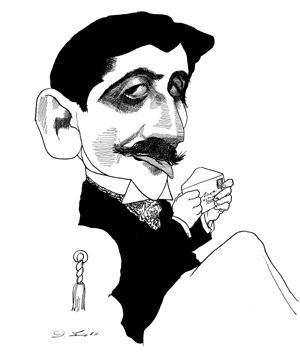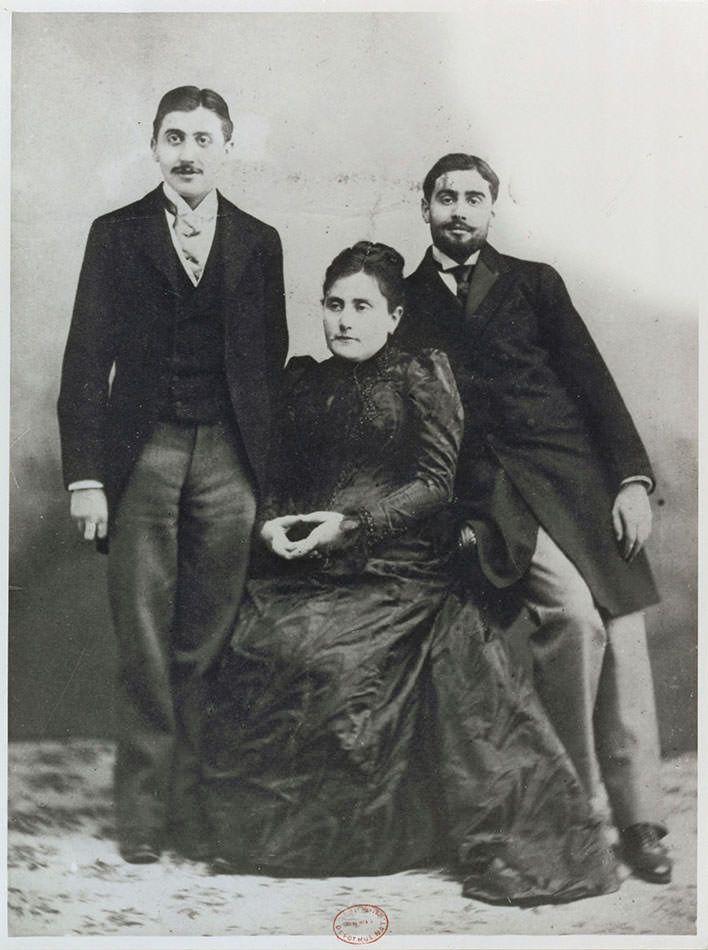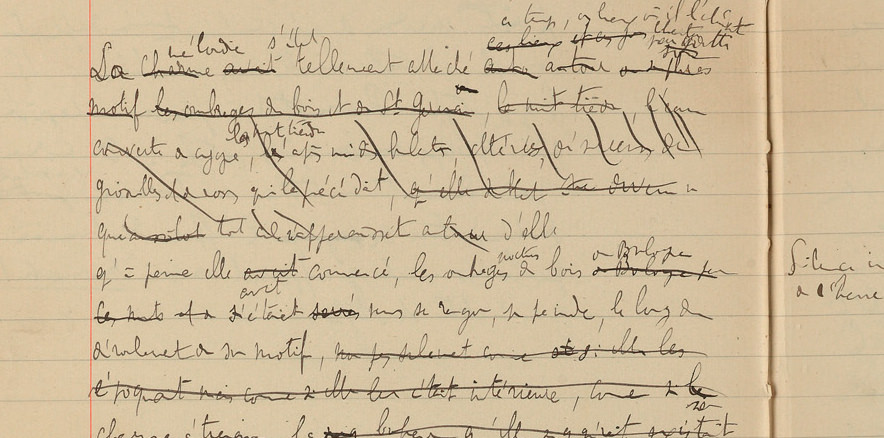A specter haunts the exhibition of Proust’s notebooks, manuscripts, and correspondence currently running at the Morgan Library. It is the specter of Proust’s mother. As you move from left to right in the room, the photograph of maman with her two sons, which appears first, sends a shiver down your spine. Mme Proust is seated, looking to the left, while her sons, young men in their twenties, stand on either side of her. They are beautifully dressed and have a look in their eyes that suggests the boulevard and the salon. There is something feline and sleek about the pair of them.
It is easy to imagine why maman is so dour-looking and disapproving, her mouth firmly closed, her eyes fixed on the ground. She is a woman who knows what trouble looks like, and these boys are ready for trouble of the most sweet and tender and pleasurable kind. As your eyes wander back to them, you can see that Marcel is more nervous about himself, his gaze not as comfortable as that of his brother Robert.
The first letter sets the scene. It is written to Marcel from his mother in 1895 when he is twenty-four and in Dieppe with Reynaldo Hahn. She is concerned about what time he goes to bed and what time he rises. Her letter is a demand for precise information. So she writes Couche and leaves a blank for him to fill in and then Leve and leaves another blank. Perhaps it is too fanciful to suggest that when he did begin to explain himself in his long novel, started a few years after his mother’s death, he had the lovely idea that his mother, by dying, had left an enormous blank for him to fill in. She wanted all the details, she wanted to be spared nothing as she sat on her chair in heaven, her eyes cast down, and he would do anything to please her.
The earliest notebooks in the exhibition suggest someone who likes notebooks more than he likes writing in them. They are long and narrow, given to him by Bizet’s widow, each line with space for no more than three or four words, and they have fin du siècle illustrations on the cover. There is a letter where the young Proust is unsure whether the work he has embarked on should be a novel or a philosophical essay. “Am I a novelist?” he asks.
Soon, as the fey notebooks are replaced by sober exercise books, it becomes clear that he is. One of his habits seemed to be to rip out pages and then paste them in elsewhere. There was much re-writing and crossing-out, including much drafting of the very opening page. The exhibition centers on the drafts and notebooks for Swann’s Way, the first volume of his great work published one hundred years ago, which belong to the collection of the Bibliothèque Nationale de France and have not left Paris before.
Visitors lining up to see the word “madeleine” as it appeared in Proust’s handwriting for the first time are in for a shock. What appears in a 1910 draft of Swann’s Way is the banal word “biscottes,” easy to spot in the manuscript. Soon Proust will find that this word will yield to another word that will open many doors for him in his narrative. But not yet. It is as though a draft of The Great Gatsby had, at first, a hero called Jones and Daisy was originally called Anne. Or the first draft of The Old Man and the Sea had the old man merely fishing for mackerel. Or that Molly Bloom, at one point in the composition of Ulysses, ended her soliloquy by saying “Maybe.”
Proust’s handwriting is bad; it is the handwriting of a novelist rather than a dandy, and visitors who can read French will have much fun making out the words and the many untidy emendations on the pages of the manuscript. In a letter to a publisher, as Proust seeks to explain what his novel is about, one word, however, stands alone and is written with a rare exactitude. In a letter to Alfred Vallette, editor of Le Mecure de France, in 1909 Proust described his work-in-progress: it “is a genuine novel and an indecent one in places. One of the principal characters is a homosexual.” The handwriting is that of a man in a hurry. Most of the words can be made out because of the context. But the word “homosexual,” as it is written in his hand here, stands alone; it is very clearly written, each letter perfectly made and totally legible. There is a feeling as you look at it that it was a word Proust did not often write, or that perhaps he enjoyed writing, or that it was a term he now wanted to take his time over, and he needed Vallette to be able to see it clearly.
Advertisement
Or perhaps it was written to be the most easily deciphered word in the entire exhibition so that maman, watching from the sky, could make it out and rest in peace, worrying her way happily into eternity, with plenty to feast on, as indeed visitors to the Morgan will have as they ponder the makings of Proust’s great work.
Marcel Proust and Swann’s Way: 100th Anniversary is on view at The Morgan Library & Museum through April 28





